American film actress Linda Darnell (1923-1965) progressed from modelling as a child to acting in theatre and film as an adolescent. The ravishing beauty appeared in supporting roles in big-budget films for 20th Century Fox throughout the 1940s and rose to fame with co-starring roles opposite Tyrone Power in adventure films. She established a main character career after her role in Forever Amber (1947) and won critical acclaim for her work in Unfaithfully Yours (1948) and A Letter to Three Wives (1949).
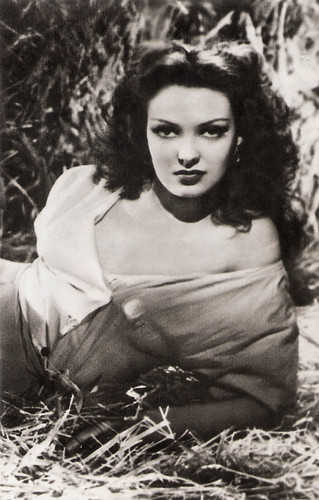
Spanish postcard by Falgra, Barcelona, no. 1136. Photo: United Artists. Publicity still for Summer Storm (Douglas Sirk, 1944).

British postcard by Valentine’s, no. 193. Photo: Twentieth Century Fox. Linda Darnell, as Burmese character Tuptim, in Anna and the King of Siam (John Cromwell, 1946). Collection: Marlene Pilaete.
Monetta Eloyse Darnell was born in Dallas, Texas, in 1923, as one of four children to postal clerk Calvin Roy Darnell and the former Pearl Brown. She was the younger sister of Undeen and the older sister of Monte Maloya and Calvin Roy, Jr. Her parents were not happily married, and she grew up as a shy and reserved girl in a house of domestic turmoil. Starting at an early age, her mother Pearl had big plans for Darnell in the entertainment industry. She believed that Linda was her only child with potential as an actress and ignored the rearing of her other children. Darnell was a model by the age of 11 and was acting on the stage by the age of 13. She initially started modelling to earn money for the household and performed mostly in beauty contests.
Darnell was a student at Sunset High School, when in November 1937, a talent scout for 20th Century Fox arrived in Dallas, looking for new faces. Encouraged by her mother, Darnell met him, and after a few months, he invited her for a screen test in Hollywood. In California, Darnell was initially rejected by film studios and was sent home because she was declared "too young". Darnell was featured in a ‘Gateway to Hollywood’ talent search and landed a contract at RKO Pictures. There was no certainty, though, and she soon returned to Dallas. When 20th Century Fox offered her a part, Darnell wanted to accept, but RKO was unwilling to release her. Nevertheless, by age 15, she was signed to a contract at 20th Century Fox and moved to a small apartment in Hollywood all alone in 1939.
Her first film was Hotel for Women (Gregory Ratoff, 1939), which had newspapers immediately hailing her as the newest star of Hollywood. Loretta Young was originally assigned to play the role but demanded a salary which the studio would not give her. Darryl F. Zanuck instead cast Darnell, advertised her beauty and suggested a Latin quality. Although only 15 at the time, Darnell posed as a 17-year-old and was listed as 19 years old by the studio. Her true age came out later in 1939, and she became one of the few actresses under the age of 16 to serve as leading ladies in films. Linda Darnell was assigned as the female lead opposite Tyrone Power in the light romantic comedy Day-Time Wife (Gregory Ratoff, 1939). Although the film received only slightly favourable reviews, Darnell's performance was received positively for her breathtaking looks and splendid acting. Life magazine stated that Darnell was "the most physically perfect girl in Hollywood".
Following the film's release, she was cast in the drama comedy Star Dust (Walter Lang, 1940) with John Payne. The film was hailed as one of the "most original entertainment ideas in years" and boosted Darnell's popularity, being nicknamed 'Hollywood's loveliest and most exciting star'. After appearing in several small films, Darnell was cast in her first big-budget film opposite Tyrone Power in Brigham Young (Henry Hathaway, 1940), regarded as the most expensive film 20th Century Fox had yet produced. Darnell and Power were cast together for the second time due to the box office success of Day-Time Wife, and they became a highly publicised onscreen couple, which prompted Darryl F. Zanuck to add 18 more romantic scenes to Brigham Young. Darnell began working on the big-budget adventure The Mark of Zorro (Rouben Mamoulian, 1940), in which she again co-starred as Power's sweetheart. Critics raved over the film. The Mark of Zorro was a box-office sensation and did much to enhance Darnell's star status.
Afterwards, she was paired with Henry Fonda for the first time in the Western Chad Hanna (Henry King, 1940), her first Technicolor film. The film received only little attention, unlike Darnell's next film Blood and Sand (Rouben Mamoulian, 1941), in which she was reteamed with Power. It was the first film for which she was widely critically acclaimed. Thereafter the studio was unable to find her suitable roles. Darnell was disappointed and felt rejected. Months passed by without any work, and in August 1941, she was cast in a supporting role in the musical Rise and Shine (Allan Dwan, 1941). The film was a setback in her career, and she was rejected for a later role because she refused to respond to Darryl F. Zanuck's advances. Instead, she contributed to the war effort, working for the Red Cross, and selling war bonds, and she was a regular at the Hollywood Canteen.
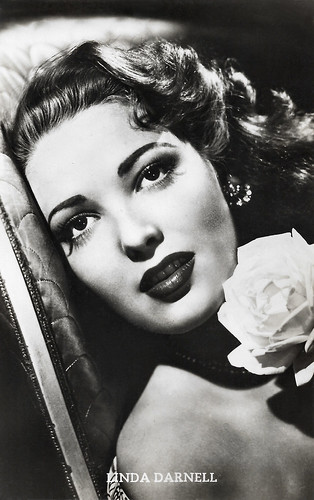
Belgian postcard, no. 750. Photo: 20th Century-Fox.
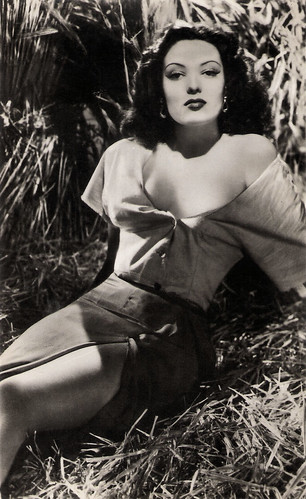
Spanish postcard. Photo: United Artists. Publicity still for Summer Storm (Douglas Sirk, 1944).
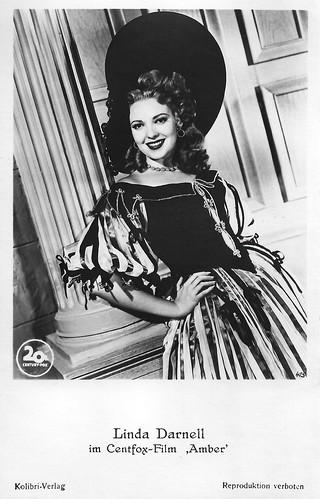
German postcard by Kolibri-Verlag. Photo: 20th Century-Fox. Publicity still for Forever Amber (Otto Preminger, 1947).
Linda Darnell and Twentieth Century Fox weren't on the best of terms, and as a punishment, she was loaned out to Columbia for a supporting role in a B-film called City Without Men (Sidney Salkow, 1942). In 1943, she was put on suspension. Darnell had married, which caused the fury of Zanuck. Darnell was reduced to second leads and was overlooked for big-budget productions. Matters changed in 1944 when Look Magazine named her one of the four most beautiful women in Hollywood, along with Hedy Lamarr, Ingrid Bergman, and Gene Tierney. The studio allowed her to be loaned out for the lead in Summer Storm (Douglas Sirk, 1944), opposite George Sanders. She played a type of role she had never before, a seductive peasant girl who takes three men to their ruin before she herself is murdered. The film provided her a new screen image as a pin-up girl.
Shortly after, Darnell was again loaned out to portray a showgirl in The Great John L. (Frank Tuttle, 1945), the first film to feature her bare legs. Darnell complained that the studio lacked recognition of her, which prodded Zanuck to cast her in the Film Noir Hangover Square (John Brahm, 1945), playing a role she personally had chosen. The film became a great success, and she was added to the cast of another Film Noir, Fallen Angel (Otto Preminger, 1945), which also included Dana Andrews and Alice Faye. Despite suffering from the "terrifying" Preminger, Darnell was praised by reviewers so widely that there was even talk of an Oscar nomination. In 1946, Darnell filmed two pictures simultaneously, the expensively budgeted Anna and the King of Siam (John Cromwell, 1946) with Irene Dunne, and Centennial Summer (Otto Preminger, 1946) with the legendary Lillian Gish.
Then she went on location in Monument Valley for the classic Western My Darling Clementine (John Ford, 1946) with Henry Fonda and Victor Mature. It was another hit and garnered Linda some of the best reviews of her career. In 1946, Linda Darnell won the starring role in the highly anticipated romantic drama Forever Amber (Otto Preminger, 1947), based on a bestselling historical novel that was denounced as being immoral at that time. Although she had to work with Preminger, she was delighted to play the title role. However, Forever Amber did not live up to its hype, and although it became a success at the box office, most reviewers agreed that the film was a disappointment.
The following year, Darnell portrayed Daphne de Carter in the comedy Unfaithfully Yours (Preston Sturges, 1948), also starring Rex Harrison, and was then one of the three wives in the comedy/drama A Letter to Three Wives (Joseph L. Mankiewicz, 1949). Darnell's hard-edged performance in the latter won her unanimous acclaim and the best reviews of her career. Darnell became one of the most demanded actresses in Hollywood, and she now had the freedom to select her own roles. She was cast opposite Richard Widmark and Veronica Lake in Slattery's Hurricane (Andre DeToth, 1949), which she perceived as a step down from the level she had reached with A Letter to Three Wives, though it did well at the box office.
She then co-starred opposite Richard Widmark and Sidney Poitier in the groundbreaking No Way Out (Joseph L. Mankiewicz, 1950). But her later films were rarely noteworthy, and her appearances were increasingly sporadic. Further hampering Darnell's career was the actress's alcoholism and weight gain. Her next films included the Western, Two Flags West (Robert Wise, 1950), The 13th Letter (Otto Preminger, 1951) and The Guy Who Came Back (Joseph M. Newman, 1951).
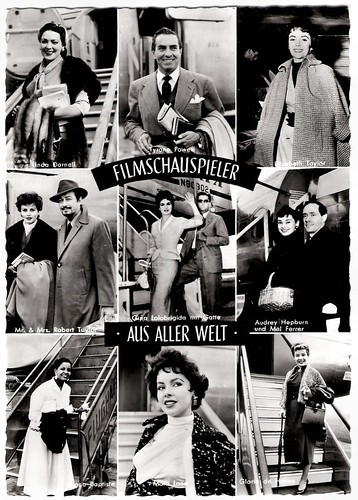
German postcard by Kunst und Film Verlag H. Lukow, Hannover, no. L2/1042. Caption: Filmschauspieler aus aller Welt (Film actors from around the world).
From top left to down right: Linda Darnell, Tyrone Power, Elizabeth Taylor, Robert Taylor and his wife Ursula Thiess, Gina Lollobrigida and her husband Milko Skofic, Audrey Hepburn and Mel Ferrer, Mona Baptiste, Mara Lane and Gloria DeHaven.

Yugoslavian postcard by Sedma Sila. Photo: IOM (Morava Film), Beograd (Belgrade).

German postcard by Kunst und Bild, Berlin, no. A 655. Photo: RKO-Film. Linda Darnell in Saturday Island (Stuart Heisler, 1952).
In 1951, Linda Darnell signed a new contract with 20th Century Fox that allowed her to become a freelance actress. Her first film outside 20th Century Fox was for Universal Pictures, The Lady Pays Off (Douglas Sirk, 1951). She was responsible for putting the film behind schedule because, on the fifth day of shooting, she learned that Ivan Kahn, the man responsible for her breakthrough, had died. Darnell then headed the cast of the British romantic war film Saturday Island (Stuart Heisler, 1952), which co-starred Tab Hunter and was filmed on location in Jamaica. There, Darnell fell ill and had to be quarantined for several weeks. Because her contract required her to make one film a year for the studio, she reported to the lot of 20th Century Fox for the Film Noir Night Without Sleep (Roy Ward Baker, 1952) with Gary Merrill and Hildegard Knef. It was the only time that she had to live up to this part of her contract, since she was released from it in September 1952.
The competition of television forced studios all over Hollywood to drop actors. This news initially excited Darnell, because it permitted her to focus on her film career in Europe, but the ease and protection enjoyed under contract was gone. Before travelling to Italy for a two-picture deal with Giuseppe Amato, Darnell was rushed into the production of Blackbeard the Pirate (Raoul Walsh, 1952). In Italy she made Donne proibite/Angels of Darkness (Giuseppe Amato, 1954) with Valentina Cortese and Giulietta Masina. The second collaboration, the French-Italian comedy Gli ultimi cinque minuti/The Last Five Minutes (Giuseppe Amato, 1955) with Vittorio De Sica and Peppino De Filippo proved disastrous, and was never released in the United States.
Back in Hollywood, she accepted an offer from Howard Hughes to star in RKO's 3-D film Second Chance (Rudolph Maté, 1953) with Robert Mitchum, filmed in Mexico. Because of her then-husband, Philip Liebmann, Darnell put her career on a hiatus. In 1955, she returned to 20th Century Fox, by which time the studio had entered the television field. She guest-starred in series like Cimarron City and Wagon Train and also returned to the stage. Linda Darnell’s last work as an actress was in a stage production in Atlanta in early 1965. At the time of her death a few months later, she was preparing to perform in another play. She died in 1965, from burns she received in a house fire in Glenview, a suburb of Chicago. The house of her former secretary and agent caught on fire in the early morning and Darnell died that afternoon in Cook County Hospital.
Linda Darnell was only 41. She had been married three times. In 1943, at age 19, she eloped with 42-year-old cameraman Peverell Marley in Las Vegas. Marley was a heavy drinker and introduced Darnell to alcohol, which eventually led to an addiction and weight problems. In 1946, during the production of Centennial Summer, she fell in love with womanising millionaire Howard Hughes. She separated from Marley but when Hughes announced that he had no desire to marry her, Darnell returned to her husband. Because Darnell and Marley were unable to have children, they adopted a daughter, Charlotte Mildred 'Lola' Marley (1948), the actress's only child. In mid-1948, she became romantically involved with director Joseph L. Mankiewicz and filed for divorce. Mankiewicz, however, did not want to leave his wife for Darnell, and though the affair continued for six years, she again returned to her husband. In 1949, Darnell went into psychotherapy for hostile emotions that she had been building since childhood. Darnell and Marley finally divorced in 1951.
In 1954, she married brewery heir Philip Liebmann but the marriage ended in 1955 on grounds of incompatibility. From 1957 to 1963, Linda Darnell was married to pilot Merle Roy Robertson. Darnell's final screen appearance was opposite Rory Calhoun in the low-budget Western Black Spurs (R.G. Springsteen, 1965).

German postcard by Film-Foto-Verlag, Berlin-Tempelhof, no. FK 284. Photo: 20th Century Fox. Linda Darnell and her daughter Charlotte. Collection: Marlene Pilaete.
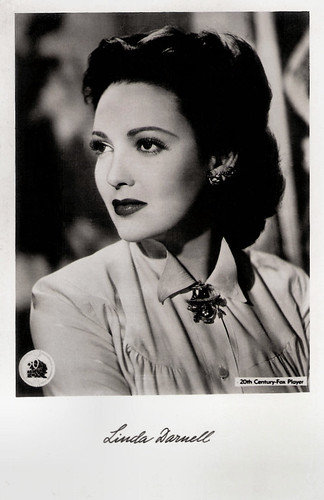
Vintage postcard. Photo: 20th Century-Fox.
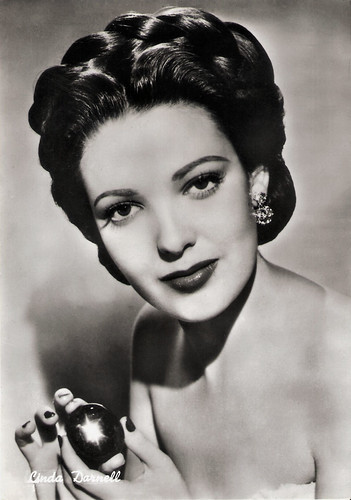
Italian postcard by Bromofoto, Milano, no. 216.
Sources: Denny Jackson (IMDb), Wikipedia and IMDb.
This post was last updated on 28 November 2023.

Spanish postcard by Falgra, Barcelona, no. 1136. Photo: United Artists. Publicity still for Summer Storm (Douglas Sirk, 1944).

British postcard by Valentine’s, no. 193. Photo: Twentieth Century Fox. Linda Darnell, as Burmese character Tuptim, in Anna and the King of Siam (John Cromwell, 1946). Collection: Marlene Pilaete.
The most physically perfect girl in Hollywood
Monetta Eloyse Darnell was born in Dallas, Texas, in 1923, as one of four children to postal clerk Calvin Roy Darnell and the former Pearl Brown. She was the younger sister of Undeen and the older sister of Monte Maloya and Calvin Roy, Jr. Her parents were not happily married, and she grew up as a shy and reserved girl in a house of domestic turmoil. Starting at an early age, her mother Pearl had big plans for Darnell in the entertainment industry. She believed that Linda was her only child with potential as an actress and ignored the rearing of her other children. Darnell was a model by the age of 11 and was acting on the stage by the age of 13. She initially started modelling to earn money for the household and performed mostly in beauty contests.
Darnell was a student at Sunset High School, when in November 1937, a talent scout for 20th Century Fox arrived in Dallas, looking for new faces. Encouraged by her mother, Darnell met him, and after a few months, he invited her for a screen test in Hollywood. In California, Darnell was initially rejected by film studios and was sent home because she was declared "too young". Darnell was featured in a ‘Gateway to Hollywood’ talent search and landed a contract at RKO Pictures. There was no certainty, though, and she soon returned to Dallas. When 20th Century Fox offered her a part, Darnell wanted to accept, but RKO was unwilling to release her. Nevertheless, by age 15, she was signed to a contract at 20th Century Fox and moved to a small apartment in Hollywood all alone in 1939.
Her first film was Hotel for Women (Gregory Ratoff, 1939), which had newspapers immediately hailing her as the newest star of Hollywood. Loretta Young was originally assigned to play the role but demanded a salary which the studio would not give her. Darryl F. Zanuck instead cast Darnell, advertised her beauty and suggested a Latin quality. Although only 15 at the time, Darnell posed as a 17-year-old and was listed as 19 years old by the studio. Her true age came out later in 1939, and she became one of the few actresses under the age of 16 to serve as leading ladies in films. Linda Darnell was assigned as the female lead opposite Tyrone Power in the light romantic comedy Day-Time Wife (Gregory Ratoff, 1939). Although the film received only slightly favourable reviews, Darnell's performance was received positively for her breathtaking looks and splendid acting. Life magazine stated that Darnell was "the most physically perfect girl in Hollywood".
Following the film's release, she was cast in the drama comedy Star Dust (Walter Lang, 1940) with John Payne. The film was hailed as one of the "most original entertainment ideas in years" and boosted Darnell's popularity, being nicknamed 'Hollywood's loveliest and most exciting star'. After appearing in several small films, Darnell was cast in her first big-budget film opposite Tyrone Power in Brigham Young (Henry Hathaway, 1940), regarded as the most expensive film 20th Century Fox had yet produced. Darnell and Power were cast together for the second time due to the box office success of Day-Time Wife, and they became a highly publicised onscreen couple, which prompted Darryl F. Zanuck to add 18 more romantic scenes to Brigham Young. Darnell began working on the big-budget adventure The Mark of Zorro (Rouben Mamoulian, 1940), in which she again co-starred as Power's sweetheart. Critics raved over the film. The Mark of Zorro was a box-office sensation and did much to enhance Darnell's star status.
Afterwards, she was paired with Henry Fonda for the first time in the Western Chad Hanna (Henry King, 1940), her first Technicolor film. The film received only little attention, unlike Darnell's next film Blood and Sand (Rouben Mamoulian, 1941), in which she was reteamed with Power. It was the first film for which she was widely critically acclaimed. Thereafter the studio was unable to find her suitable roles. Darnell was disappointed and felt rejected. Months passed by without any work, and in August 1941, she was cast in a supporting role in the musical Rise and Shine (Allan Dwan, 1941). The film was a setback in her career, and she was rejected for a later role because she refused to respond to Darryl F. Zanuck's advances. Instead, she contributed to the war effort, working for the Red Cross, and selling war bonds, and she was a regular at the Hollywood Canteen.

Belgian postcard, no. 750. Photo: 20th Century-Fox.

Spanish postcard. Photo: United Artists. Publicity still for Summer Storm (Douglas Sirk, 1944).

German postcard by Kolibri-Verlag. Photo: 20th Century-Fox. Publicity still for Forever Amber (Otto Preminger, 1947).
A new screen image as a pin-up girl
Linda Darnell and Twentieth Century Fox weren't on the best of terms, and as a punishment, she was loaned out to Columbia for a supporting role in a B-film called City Without Men (Sidney Salkow, 1942). In 1943, she was put on suspension. Darnell had married, which caused the fury of Zanuck. Darnell was reduced to second leads and was overlooked for big-budget productions. Matters changed in 1944 when Look Magazine named her one of the four most beautiful women in Hollywood, along with Hedy Lamarr, Ingrid Bergman, and Gene Tierney. The studio allowed her to be loaned out for the lead in Summer Storm (Douglas Sirk, 1944), opposite George Sanders. She played a type of role she had never before, a seductive peasant girl who takes three men to their ruin before she herself is murdered. The film provided her a new screen image as a pin-up girl.
Shortly after, Darnell was again loaned out to portray a showgirl in The Great John L. (Frank Tuttle, 1945), the first film to feature her bare legs. Darnell complained that the studio lacked recognition of her, which prodded Zanuck to cast her in the Film Noir Hangover Square (John Brahm, 1945), playing a role she personally had chosen. The film became a great success, and she was added to the cast of another Film Noir, Fallen Angel (Otto Preminger, 1945), which also included Dana Andrews and Alice Faye. Despite suffering from the "terrifying" Preminger, Darnell was praised by reviewers so widely that there was even talk of an Oscar nomination. In 1946, Darnell filmed two pictures simultaneously, the expensively budgeted Anna and the King of Siam (John Cromwell, 1946) with Irene Dunne, and Centennial Summer (Otto Preminger, 1946) with the legendary Lillian Gish.
Then she went on location in Monument Valley for the classic Western My Darling Clementine (John Ford, 1946) with Henry Fonda and Victor Mature. It was another hit and garnered Linda some of the best reviews of her career. In 1946, Linda Darnell won the starring role in the highly anticipated romantic drama Forever Amber (Otto Preminger, 1947), based on a bestselling historical novel that was denounced as being immoral at that time. Although she had to work with Preminger, she was delighted to play the title role. However, Forever Amber did not live up to its hype, and although it became a success at the box office, most reviewers agreed that the film was a disappointment.
The following year, Darnell portrayed Daphne de Carter in the comedy Unfaithfully Yours (Preston Sturges, 1948), also starring Rex Harrison, and was then one of the three wives in the comedy/drama A Letter to Three Wives (Joseph L. Mankiewicz, 1949). Darnell's hard-edged performance in the latter won her unanimous acclaim and the best reviews of her career. Darnell became one of the most demanded actresses in Hollywood, and she now had the freedom to select her own roles. She was cast opposite Richard Widmark and Veronica Lake in Slattery's Hurricane (Andre DeToth, 1949), which she perceived as a step down from the level she had reached with A Letter to Three Wives, though it did well at the box office.
She then co-starred opposite Richard Widmark and Sidney Poitier in the groundbreaking No Way Out (Joseph L. Mankiewicz, 1950). But her later films were rarely noteworthy, and her appearances were increasingly sporadic. Further hampering Darnell's career was the actress's alcoholism and weight gain. Her next films included the Western, Two Flags West (Robert Wise, 1950), The 13th Letter (Otto Preminger, 1951) and The Guy Who Came Back (Joseph M. Newman, 1951).

German postcard by Kunst und Film Verlag H. Lukow, Hannover, no. L2/1042. Caption: Filmschauspieler aus aller Welt (Film actors from around the world).
From top left to down right: Linda Darnell, Tyrone Power, Elizabeth Taylor, Robert Taylor and his wife Ursula Thiess, Gina Lollobrigida and her husband Milko Skofic, Audrey Hepburn and Mel Ferrer, Mona Baptiste, Mara Lane and Gloria DeHaven.

Yugoslavian postcard by Sedma Sila. Photo: IOM (Morava Film), Beograd (Belgrade).

German postcard by Kunst und Bild, Berlin, no. A 655. Photo: RKO-Film. Linda Darnell in Saturday Island (Stuart Heisler, 1952).
Alcohol addiction and weight problems
In 1951, Linda Darnell signed a new contract with 20th Century Fox that allowed her to become a freelance actress. Her first film outside 20th Century Fox was for Universal Pictures, The Lady Pays Off (Douglas Sirk, 1951). She was responsible for putting the film behind schedule because, on the fifth day of shooting, she learned that Ivan Kahn, the man responsible for her breakthrough, had died. Darnell then headed the cast of the British romantic war film Saturday Island (Stuart Heisler, 1952), which co-starred Tab Hunter and was filmed on location in Jamaica. There, Darnell fell ill and had to be quarantined for several weeks. Because her contract required her to make one film a year for the studio, she reported to the lot of 20th Century Fox for the Film Noir Night Without Sleep (Roy Ward Baker, 1952) with Gary Merrill and Hildegard Knef. It was the only time that she had to live up to this part of her contract, since she was released from it in September 1952.
The competition of television forced studios all over Hollywood to drop actors. This news initially excited Darnell, because it permitted her to focus on her film career in Europe, but the ease and protection enjoyed under contract was gone. Before travelling to Italy for a two-picture deal with Giuseppe Amato, Darnell was rushed into the production of Blackbeard the Pirate (Raoul Walsh, 1952). In Italy she made Donne proibite/Angels of Darkness (Giuseppe Amato, 1954) with Valentina Cortese and Giulietta Masina. The second collaboration, the French-Italian comedy Gli ultimi cinque minuti/The Last Five Minutes (Giuseppe Amato, 1955) with Vittorio De Sica and Peppino De Filippo proved disastrous, and was never released in the United States.
Back in Hollywood, she accepted an offer from Howard Hughes to star in RKO's 3-D film Second Chance (Rudolph Maté, 1953) with Robert Mitchum, filmed in Mexico. Because of her then-husband, Philip Liebmann, Darnell put her career on a hiatus. In 1955, she returned to 20th Century Fox, by which time the studio had entered the television field. She guest-starred in series like Cimarron City and Wagon Train and also returned to the stage. Linda Darnell’s last work as an actress was in a stage production in Atlanta in early 1965. At the time of her death a few months later, she was preparing to perform in another play. She died in 1965, from burns she received in a house fire in Glenview, a suburb of Chicago. The house of her former secretary and agent caught on fire in the early morning and Darnell died that afternoon in Cook County Hospital.
Linda Darnell was only 41. She had been married three times. In 1943, at age 19, she eloped with 42-year-old cameraman Peverell Marley in Las Vegas. Marley was a heavy drinker and introduced Darnell to alcohol, which eventually led to an addiction and weight problems. In 1946, during the production of Centennial Summer, she fell in love with womanising millionaire Howard Hughes. She separated from Marley but when Hughes announced that he had no desire to marry her, Darnell returned to her husband. Because Darnell and Marley were unable to have children, they adopted a daughter, Charlotte Mildred 'Lola' Marley (1948), the actress's only child. In mid-1948, she became romantically involved with director Joseph L. Mankiewicz and filed for divorce. Mankiewicz, however, did not want to leave his wife for Darnell, and though the affair continued for six years, she again returned to her husband. In 1949, Darnell went into psychotherapy for hostile emotions that she had been building since childhood. Darnell and Marley finally divorced in 1951.
In 1954, she married brewery heir Philip Liebmann but the marriage ended in 1955 on grounds of incompatibility. From 1957 to 1963, Linda Darnell was married to pilot Merle Roy Robertson. Darnell's final screen appearance was opposite Rory Calhoun in the low-budget Western Black Spurs (R.G. Springsteen, 1965).

German postcard by Film-Foto-Verlag, Berlin-Tempelhof, no. FK 284. Photo: 20th Century Fox. Linda Darnell and her daughter Charlotte. Collection: Marlene Pilaete.

Vintage postcard. Photo: 20th Century-Fox.

Italian postcard by Bromofoto, Milano, no. 216.
Sources: Denny Jackson (IMDb), Wikipedia and IMDb.
This post was last updated on 28 November 2023.
No comments:
Post a Comment